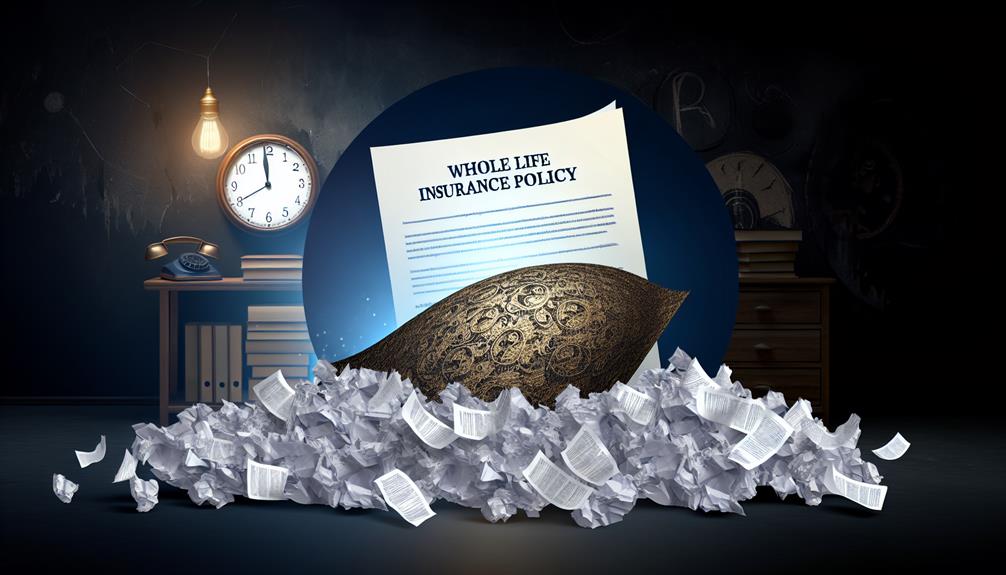When choosing between term and whole life insurance, consider your financial needs. Term life offers affordable, temporary coverage, making it suitable for specific obligations like mortgages or child-rearing. Its lower premiums can help you manage short-term financial goals. In contrast, whole life provides lifelong coverage and builds cash value, which can be a financial asset over time, albeit at a higher premium cost. Your decision should reflect your long-term financial strategy and personal circumstances. Understanding these differences will guide you in selecting the best option for your situation, and further insights could clarify your choice.
Key Takeaways
- Term life insurance is cost-effective, ideal for temporary needs like child-rearing or mortgages, with lower average premiums than whole life.
- Whole life insurance provides lifelong coverage with cash value growth, suitable for long-term financial security and retirement planning.
- Consider your financial goals: term life fits short-term obligations, while whole life offers ongoing support for long-term financial stability.
- Evaluate life changes regularly; major events may necessitate adjustments in coverage type or amounts to ensure adequate protection.
- Explore alternatives like Guaranteed Universal Life or Indexed Universal Life for tailored solutions that may better fit your financial needs and budget.
Overview of Life Insurance Types
When considering life insurance options, it's crucial to understand the two primary types: term life and whole life insurance. Term life insurance provides coverage for a specified period—like 10, 20, or 30 years—making it a practical choice if you need temporary financial protection. Typically, term policies have lower premiums compared to whole life insurance, which can be more budget-friendly for those seeking short-term solutions.
On the other hand, whole life insurance offers lifelong coverage and includes a cash value component that grows tax-deferred over time. This cash value can be borrowed against or withdrawn, providing financial flexibility that term policies lack. However, it's significant to recognize that while both types provide a death benefit paid tax-free to beneficiaries, term insurance only pays out if the insured dies within the policy term. In contrast, whole life guarantees a payout regardless of when the insured passes away.
Understanding these differences between term and whole life insurance allows you to make a more informed decision based on your financial goals and coverage needs.
Benefits of Term Life Insurance
Term life insurance offers cost-effective coverage, making it an attractive choice for individuals seeking affordable financial protection. Its simplified structure means you can easily understand the benefits and terms, allowing you to focus on securing support for your dependents. With lower premiums and clear options, it aligns well with temporary financial needs.
Cost-Effective Coverage
For many individuals, cost-effective coverage is a primary consideration when selecting life insurance, and term life insurance stands out as an ideal option. It's typically more affordable than whole life insurance, with average premiums for a 30-year term policy being about $33.24/month for men and $27.31/month for women. This makes it easier for you to secure affordable life insurance that meets your immediate financial needs.
Term life insurance provides straightforward coverage tailored to your financial obligations, such as child-rearing or mortgage payments. You can select coverage for a specific period, ensuring it aligns with your financial planning goals without the complexity of cash value accumulation.
Here's a quick comparison of term life insurance benefits:
| Feature | Term Life Insurance | Whole Life Insurance |
|---|---|---|
| Cost | Lower Average Premiums | Higher Average Premiums |
| Cash Value | No | Yes |
| Coverage Duration | Specific Term | Lifetime |
With various term options available (10, 15, 20, 25, or 30 years), term life insurance offers flexibility, helping you allocate funds to other priorities while ensuring your dependents are protected.
Simplified Structure
Choosing the right life insurance policy involves understanding the structure of the options available. Term life insurance provides a clear structure that makes it easy for you to comprehend. Unlike whole life insurance, which can be complex with cash value components, term life insurance focuses solely on delivering a death benefit. This simplicity is appealing, especially for those seeking straightforward financial protection for their loved ones.
With term life insurance, you can select a coverage duration that aligns with your specific financial obligations—options typically range from 10 to 30 years. This flexibility allows you to guarantee that your dependents are protected during critical life stages, such as raising children or managing a mortgage.
Additionally, term life insurance is affordable, with average monthly premiums around $33.24 for men and $27.31 for women, making it a practical choice for budget-conscious individuals. Since it serves as a purely protective measure, it doesn't accumulate cash value but guarantees a death benefit if you pass away during the policy term. This straightforward approach assures that policyholders can easily navigate their options and make informed decisions about their life insurance needs.
Benefits of Whole Life Insurance

Whole life insurance offers you lifelong coverage, ensuring that your beneficiaries receive a death benefit no matter when you pass away. Additionally, the policy's cash value grows at a guaranteed rate, providing a reliable savings component that can be accessed later. This combination of coverage and cash accumulation can enhance your financial planning flexibility, making whole life insurance a strategic choice for various life circumstances.
Lifelong Coverage Assurance
With lifelong coverage guarantee, whole life insurance offers a level of financial security that can be invaluable for policyholders and their beneficiaries. One of the key features is the guaranteed death benefit, which guarantees that your loved ones receive financial support regardless of when you pass away. As long as premiums are paid, this lifelong coverage remains intact, providing peace of mind for those with long-term financial commitments.
The premiums for whole life insurance remain level throughout your life, allowing for predictable costs in your financial planning. This stability is especially beneficial for individuals supporting dependents, such as parents with disabled children, who require guarantee of ongoing financial support. Additionally, whole life policies accumulate cash value over time, growing at a guaranteed rate on a tax-deferred basis. This accumulation can enhance your financial situation, as it may offer dividends based on the insurer's performance, which can be used to pay premiums or increase cash value.
Cash Value Accumulation
Offering a unique blend of insurance and savings, cash value accumulation is one of the most significant advantages of whole life insurance. With a permanent life insurance policy, you not only receive a death benefit but also the opportunity to build cash value over time. This cash value grows at a guaranteed rate, providing a predictable savings element that term life insurance simply doesn't offer.
As a policyholder, you can access this cash value through loans or withdrawals, giving you the flexibility to withdraw funds for emergencies or retirement planning. Importantly, the cash value accumulates on a tax-deferred basis, meaning you won't face immediate tax implications when accessing these funds. Additionally, some whole life policies may pay dividends based on the insurance company's performance, potentially enhancing your cash value growth further.
However, it's crucial to keep in mind that outstanding loans can reduce the death benefit, affecting your financial security for your beneficiaries. Overall, the ability to build cash value makes whole life insurance a compelling choice for those seeking lifelong coverage combined with a reliable savings component.
Financial Planning Flexibility
The financial planning flexibility provided by whole life insurance is a significant advantage for policyholders looking to secure their future. Unlike term life insurance, which offers coverage for a limited period, whole life insurance provides permanent coverage and guarantees that your beneficiaries receive a death benefit regardless of when you pass away, as long as premiums are maintained.
One of the key features of whole life insurance is its cash value component. This cash value grows at a guaranteed rate on a tax-deferred basis, allowing you to accumulate savings that can be accessed for loans or withdrawals. This feature adds a layer of financial planning flexibility, particularly as you consider retirement savings. Additionally, whole life policies may offer dividends based on the insurer's performance, giving you extra options for reinvestment or cash withdrawal.
Moreover, whole life insurance plays an essential role in estate planning, as it guarantees death benefits to cover final expenses and taxes, making certain that your heirs receive the intended financial support without incurring additional tax burdens. This combination of features makes whole life insurance a versatile tool in your overall financial strategy.
Drawbacks of Term Life Insurance
Term life insurance, while appealing for its affordability and straightforward structure, comes with several notable drawbacks that potential policyholders should consider.
| Drawback | Explanation |
|---|---|
| Limited Coverage Period | It only provides coverage for a limited period, typically 10 to 30 years. |
| Expires Without Payout | If you outlive the term, the policy expires without payout, leaving you without a safety net. |
| No Cash Value | Unlike whole life, there's no cash value accumulation, meaning it can't serve as a wealth-building tool. |
| Risk of Financial Loss | Paying premiums consistently but receiving no death benefit can result in financial loss. |
| Higher Premiums on Renewal | Upon renewal, premiums can increase considerably due to the insured's increased age and potential health changes. |
These factors indicate that while term life insurance might seem cost-effective initially, the long-term implications can lead to unexpected challenges, especially if you rely heavily on the death benefit or expect to renew coverage later. It's crucial to weigh these drawbacks against your personal financial goals and needs.
Drawbacks of Whole Life Insurance

Whole life insurance presents several drawbacks that potential buyers should carefully assess before committing. While it offers lifelong coverage, the associated whole life premiums are considerably higher—about 17 times more than term life insurance. This high cost represents a substantial financial commitment that may pose challenges in maintaining coverage, particularly if your financial situation changes.
Additionally, the complexity of whole life policies can be intimidating. The cash value component and various features might confuse consumers, making it difficult to fully understand the policy's benefits and limits.
Here are three key drawbacks of whole life insurance to reflect on:
- Surrender Charges: If you decide to cancel your policy early, surrender charges may apply, leading to a loss of cash value and benefits.
- Limited Wealth-Building Potential: Although whole life policies accumulate cash value, the growth is generally slower than other investment options, which can limit your wealth-building potential.
- High Premiums: The ongoing high premiums can strain your budget and make it challenging to sustain your policy long-term.
Coverage Duration and Policy Options
When considering life insurance options, understanding the coverage duration and policy features is essential for making an informed decision. Term life insurance offers coverage for a specified duration, typically ranging from 10 to 30 years. It pays out only if you pass away during this period, meaning there's no cash return if the policy expires without a claim. In contrast, whole life insurance provides lifelong coverage, remaining active as long as you continue to pay the premiums. Some policies even extend coverage until you reach ages 90, 100, or 120.
One of the key policy options in term life insurance is the potential for renewal or conversion to whole life insurance before expiration. This flexibility allows you to secure continued coverage or start accumulating cash value, which is a significant feature of whole life policies. Whole life insurance often includes a cash value component that grows over time, offering you the ability to borrow against or withdraw funds, thereby providing additional financial flexibility compared to term policies. Ultimately, the choice between these options depends on your individual needs for coverage duration and financial goals.
Converting Term to Whole Life

Converting a term life insurance policy to a whole life policy can be a strategic move for many policyholders. This change allows you to secure lifelong coverage and a guaranteed death benefit, enhancing your long-term financial security. Here are three key considerations when converting term to whole life:
- Cash Value Accumulation: Whole life policies typically accumulate cash value over time. This can be useful for retirement planning, offering a financial resource you can tap into later.
- Insurance Premiums: While premiums for the whole life policy may be higher than your original term premiums, their manageable nature can improve as cash value accumulates. This shift can make your financial obligations easier to handle.
- Conversion Options: Not all term policies offer the same conversion options. Be sure to review your specific policy for age limits or time restrictions, as these can impact your ability to convert.
Ultimately, converting term to whole life can provide you with the peace of mind that comes from knowing your coverage won't expire, allowing you to focus on your financial future.
When to Reassess Your Insurance Needs
Life insurance needs aren't static; they evolve as your circumstances change. It's crucial to regularly assess your insurance needs, especially during major life events like marriage, the birth of a child, or retirement. These milestones can greatly impact your financial responsibilities and, consequently, the type and amount of coverage you require.
If you're in your 60s or 70s, it's particularly important to evaluate your life insurance coverage. By this stage, you may find that you no longer need coverage due to grown children and paid-off debts. However, maintaining a policy may still be beneficial for estate planning purposes.
Regular assessments help guarantee your current policy aligns with your financial goals. You should consider adjusting or even dropping coverage based on changes in income and dependents. Additionally, as a policyholder nearing the end of a term life insurance policy, it's wise to explore conversion options to whole life insurance, especially if your health has improved.
Incorporating periodic evaluations into your financial planning allows you to adapt your life insurance strategy to meet your evolving needs effectively.
Alternatives to Term and Whole Life Insurance

Exploring alternatives to term and whole life insurance can help you find a policy that better fits your financial situation and goals. Here are three notable options:
- Guaranteed Universal Life (GUL): This option offers lifelong coverage with flexible premiums and no cash value component. It's generally more affordable than whole life insurance while ensuring a death benefit.
- Indexed Universal Life Insurance: This policy links cash value growth to a stock market index, providing potential for higher returns. It still offers a death benefit and flexible premium payments, making it an appealing choice for those wanting growth potential.
- Burial Insurance (Final Expense Insurance): Specifically designed to cover funeral costs and final expenses, this insurance usually comes with lower coverage amounts and simplified underwriting, addressing immediate financial needs.
Additionally, you might consider laddering life insurance, which involves purchasing multiple term policies with different expiration dates. This strategy can help tailor coverage to your evolving financial needs while keeping costs manageable. Each of these alternatives presents unique benefits that could align more closely with your specific financial goals.
Frequently Asked Questions
Is It Better to Have Whole Life or Term Life Insurance?
When considering whether whole life or term life insurance is better for you, it's essential to evaluate cost comparison. Term offers lower premiums for a specific coverage duration, while whole life has higher premium differences but includes investment potential through cash value. Think about your financial goals and beneficiary considerations. Also, consider tax implications and policy flexibility—term can convert to whole if needed, allowing for tailored risk assessment based on your changing circumstances.
Should I Switch My Term Life Insurance to Whole Life?
Should you switch your term life insurance to whole life? Consider the cost comparison and the premium stability of whole life, which often comes with considerably higher costs. Evaluate your coverage needs and family considerations, alongside your long-term financial goals. The investment potential and tax implications of whole life can be beneficial, but assess the flexibility options available in your current policy. Ultimately, weigh the benefits against your ability to maintain these premiums over time.
When Might Term Insurance Be a Better Option Than Whole Life Insurance?
When considering your coverage needs, term insurance might be better if you prioritize premium affordability and a straightforward cost comparison. It's ideal for temporary protection during specific policy durations, like raising kids or paying off a mortgage. If your financial goals involve minimal investment components, term provides pure insurance without cash value. Additionally, age factors play a role; you may not need coverage later in life, making term a strategic choice for many.
Which Type of Life Insurance Is the Better Option?
When deciding which type of life insurance is better, consider premium costs, coverage duration, and your financial goals. Term insurance offers lower premiums for temporary coverage, while whole life includes an investment component with cash value growth but at a higher cost. Assess your family's needs and health considerations, along with age factors and risk tolerance. Ultimately, choose a policy that aligns with your long-term financial objectives and provides adequate protection for your dependents.

Leave a Reply